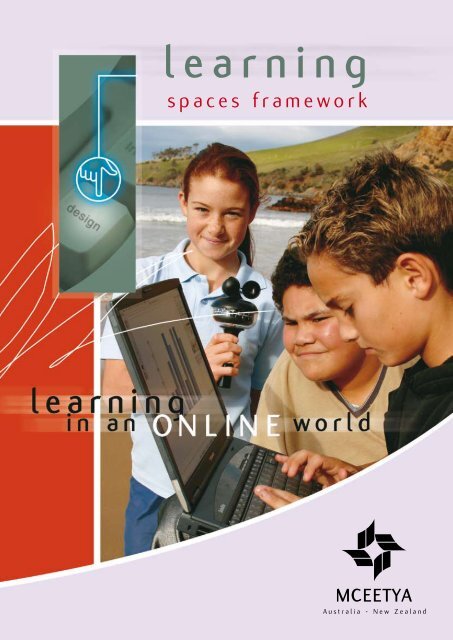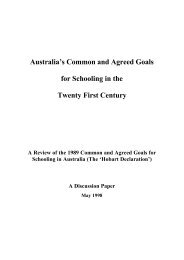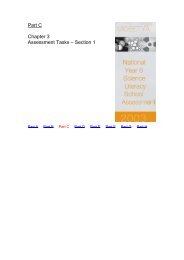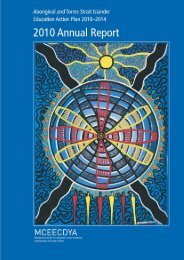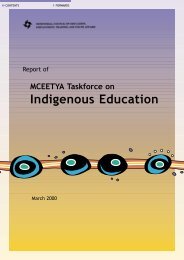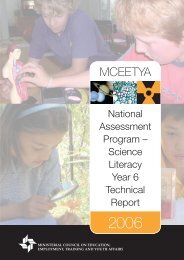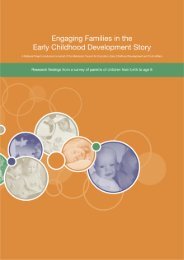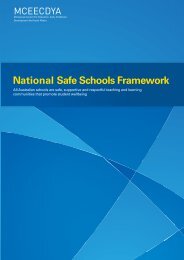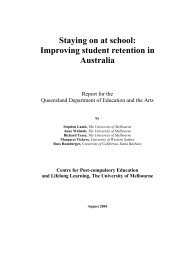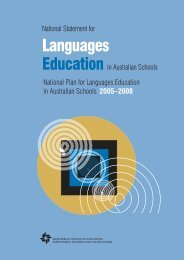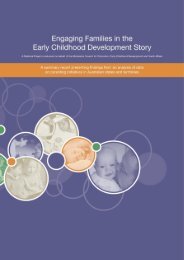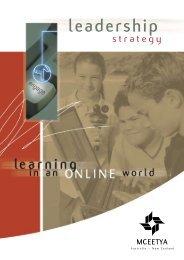Learning Spaces Framework - Ministerial Council for Education ...
Learning Spaces Framework - Ministerial Council for Education ...
Learning Spaces Framework - Ministerial Council for Education ...
Create successful ePaper yourself
Turn your PDF publications into a flip-book with our unique Google optimized e-Paper software.
learning<br />
spaces framework<br />
1 MCEETYA<br />
Australia – - New Zealand
learning<br />
spaces framework<br />
<strong>Spaces</strong> shape and change practice. Engaging, adaptable spaces energise<br />
students, teachers and the community. Well-designed learning spaces<br />
inspire creative, productive and efficient learning.<br />
cataloguing – in publication data<br />
<strong>Learning</strong> spaces framework: learning in an online world.<br />
ISBN 1 920865 00 4.<br />
1. Internet in education.<br />
2. <strong>Education</strong> - Computer network resources.<br />
3. Teaching - Computer network resources.<br />
4. Innovations in education<br />
I. <strong>Ministerial</strong> <strong>Council</strong> on <strong>Education</strong>, Employment,<br />
Training and Youth Affairs (Australia and New Zealand).<br />
371.3344678<br />
2<br />
© 2008 Curriculum Corporation as the legal entity<br />
<strong>for</strong> the <strong>Ministerial</strong> <strong>Council</strong> on <strong>Education</strong>, Employment,<br />
Training and Youth Affairs (MCEETYA).<br />
Curriculum Corporation as the legal entity <strong>for</strong> the <strong>Ministerial</strong> <strong>Council</strong><br />
on <strong>Education</strong>, Employment, Training and Youth Affairs (MCEETYA)<br />
owns the copyright in this publication. This publication or any part<br />
of it may be used freely only <strong>for</strong> non-profit education purposes<br />
provided the source is clearly acknowledged. The publication may<br />
not be sold or used <strong>for</strong> any other commercial purpose.<br />
Other than as permitted above or by the Copyright Act 1968<br />
(Commonwealth), no part of this publication may be reproduced,<br />
stored, published, per<strong>for</strong>med, communicated or adapted, regardless<br />
of the <strong>for</strong>m or means (electronic, photocopying or otherwise),<br />
without the prior written permission of the copyright owner. Address<br />
inquiries regarding copyright to:<br />
MCEETYA Secretariat, PO Box 202,<br />
Carlton South, VIC 3053, Australia.
Context 4<br />
Repositioning Thinking<br />
Designing <strong>for</strong> <strong>Learning</strong><br />
Guiding Principles 6<br />
<strong>Learning</strong> <strong>Spaces</strong> <strong>Framework</strong> 7<br />
Changing the Culture of Schools 9<br />
Teaching and <strong>Learning</strong><br />
Leadership<br />
Strategic Decision-Making<br />
ICT-Rich <strong>Learning</strong> <strong>Spaces</strong> 10<br />
Purpose<br />
Considerations<br />
Designing <strong>Spaces</strong> <strong>for</strong> <strong>Learning</strong> 18<br />
Compliance<br />
Technology<br />
Quality Design<br />
Useful Sites<br />
Planning and Decision-Making 22<br />
List of Diagrams<br />
Figure 1: Student <strong>Learning</strong> 5<br />
Figure 2: Learnng spaces framework 7<br />
Figure 3: Connecting Devices, Resources and Systems 13<br />
Figure 4: Digital Devices and Systems 14<br />
Figure 5: Overview of Content Flow 15<br />
Figure 6: Virtual <strong>Learning</strong> Space 16<br />
Figure 7: Decision-Making 20<br />
3<br />
contents<br />
Figure 8: Checklist 23
learning<br />
spaces framework<br />
Contemporary learning – learning in an online<br />
world describes the integrated nature of the<br />
highly technological world in which young people<br />
live and learn. A key priority is to design learning<br />
spaces that integrate technologies: engaging<br />
students in ways not previously possible; creating<br />
new learning and teaching possibilities; enhancing<br />
achievement and extending interactions with local<br />
and global communities.<br />
The <strong>Learning</strong> spaces framework is designed to<br />
guide high-level strategic decision-making in<br />
jurisdictions and schools. It provides advice<br />
on key issues to consider when planning new<br />
schools, major redevelopment projects, and<br />
refurbishing or repurposing existing learning<br />
spaces in schools.<br />
<strong>Learning</strong> spaces, both physical and virtual, are<br />
the planned environments in which learning<br />
takes place. 21st century learning requires new<br />
spaces that connect school, home and community<br />
learning, increasing flexibility and supporting<br />
learning outside the boundaries of school buildings<br />
and beyond the conventional school day.<br />
Repositioning Thinking<br />
4<br />
context<br />
Changing demographics, social interaction and<br />
student learning styles require greater flexibility<br />
in schools. Today’s students represent the<br />
first generations to grow up in a world where<br />
in<strong>for</strong>mation and communications technologies<br />
(ICT) are ubiquitous.<br />
Students approach their lives and their daily<br />
activities differently. Mobile technologies,<br />
computers, video gaming, digital music players,<br />
video cameras, chat, blogs, wikis and virtual<br />
spaces are intrinsic to their world. Current<br />
technologies shape their expectations and their<br />
abilities to access, acquire, manipulate, construct,<br />
create and communicate in<strong>for</strong>mation.<br />
The social nature of learning is enhanced in<br />
spaces that encourage both <strong>for</strong>mal and in<strong>for</strong>mal<br />
communities. Technology, now more mobile and<br />
af<strong>for</strong>dable, facilitates greater access to content<br />
and resources with real-time communication<br />
and collaboration. Interior design, furniture<br />
and learning space management are important<br />
considerations.
Designing <strong>for</strong> <strong>Learning</strong><br />
Maximising student learning is at the heart<br />
of decisions about the design or re-design of<br />
learning spaces. The skills students acquire are<br />
influenced by the design of learning spaces, the<br />
effective use of ICT and the ways in which leaders<br />
change the nature and culture of schooling to<br />
reflect the needs of learners in the 21st century.<br />
Self-directing<br />
Communicating<br />
Negotiating<br />
Collaborating<br />
Working in teams<br />
Respecting diversity<br />
Behaving ethically<br />
STUDENTS<br />
Conceptualising<br />
Acquiring knowledge<br />
Thinking critically<br />
Solving problems<br />
Taking risks<br />
Innovating<br />
Working creatively<br />
Creating knowledge<br />
Figure 1: Student <strong>Learning</strong><br />
<strong>Learning</strong> is enhanced, deepened and made more<br />
relevant when connected learning spaces provide<br />
opportunities <strong>for</strong>:<br />
• active and interactive participation<br />
• collaborative project work<br />
• in<strong>for</strong>mation retrieval and sharing<br />
• discussion and presentation<br />
•∑ production of new knowledge<br />
•∑ teacher and student-led activities<br />
•∑ connection with experts<br />
•∑ local and global networks<br />
• personalised learning.<br />
5<br />
context
learning<br />
spaces framework<br />
Guiding Principles<br />
guiding principles<br />
The following principles constitute a high-level strategic guide <strong>for</strong> the design of new schools, the redevelopment<br />
of schools, and the re-purposing of buildings and learning spaces to maximise student<br />
per<strong>for</strong>mance.<br />
Flexibility - supporting<br />
• multiple users and use<br />
• physical, virtual and blended learning environments<br />
• space re-allocation and re-configuration.<br />
Inclusivity – accommodating<br />
• access and participation <strong>for</strong> all<br />
• local demographic needs<br />
• personalised learning.<br />
Collaboration – enabling<br />
• cooperative learning, teamwork and enterprise<br />
• community, professional and expert engagement<br />
• local, national and global networks, partnerships and learning communities.<br />
Creativity – achieving<br />
• engagement, innovation and learning<br />
• community and environmental harmony<br />
• growth of social capital.<br />
Efficiency– delivering<br />
• faster, deeper learning<br />
• sustainable, cost-effective utilities and delivery<br />
• effective management and administration.<br />
Decisions about the design or re-design of physical and virtual learning spaces are made within the<br />
context and policies framing the operation of schools, and changing the culture of schooling.<br />
6
learning spaces framework<br />
Different spaces are required <strong>for</strong> effective<br />
learning in the 21st century.<br />
The <strong>Learning</strong> spaces framework uses four<br />
organisers to raise key issues that need<br />
to be considered as the guiding principles<br />
are applied.<br />
Designing spaces <strong>for</strong> learning<br />
STUDENTS<br />
Creating ICT rich learning spaces<br />
Planning and decision making<br />
Figure 2: <strong>Learning</strong> spaces framework<br />
7<br />
Organisers:<br />
• changing the culture of schooling<br />
• creating ICT rich learning spaces<br />
•∑ designing spaces <strong>for</strong> learning<br />
•∑ planning and decision-making.<br />
Changing the culture of schooling
learning<br />
spaces framework<br />
STUDENTS<br />
STUDENTS<br />
STUDENTS<br />
STUDENTS<br />
learning spaces framework<br />
Changing the culture of schooling requires educators, planners, architects and the<br />
community to consider:<br />
• learning beyond the boundaries of the school and the conventional school day<br />
• new pedagogies, learning goals and worksites<br />
• trans<strong>for</strong>mative leadership strategies and practices.<br />
Creating ICT rich learning environments requires educators, planners, architects and<br />
the community to consider:<br />
• networked communities<br />
• flexible access to learning<br />
• efficiencies using digital content, tools and services.<br />
Designing spaces <strong>for</strong> learning requires educators, planners, architects and the<br />
community to consider:<br />
• inclusivity, engagement, and interaction<br />
• experimentation, innovation and knowledge creation<br />
• adaptability, safety and sustainability.<br />
Planning and decision-making requires educators, planners, architects and the<br />
community to consider:<br />
• current educational philosophy and future projections<br />
• expertise from multiple disciplines, students and the community<br />
• systematic decision-making processes.<br />
8
STUDENTS<br />
changing the culture of schooling<br />
Home, school and community spaces, both<br />
virtual and physical are increasing in flexibility,<br />
with learning taking place beyond the boundaries<br />
of school buildings and the conventional school<br />
day. Students expect environments to be ICT<br />
rich, compatible and interconnected.<br />
Students communicate and acquire in<strong>for</strong>mation<br />
both within and outside their <strong>for</strong>mal learning<br />
programs. Connecting more closely with<br />
communities enriches learning and reduces the<br />
effects of disaffection and remoteness.<br />
Teaching and <strong>Learning</strong><br />
Curriculum is focused on understanding, rigour<br />
and relevance. ICT capabilities are integral to<br />
success in a connected, fast-moving, demanding<br />
world.<br />
Conceptualisation and meta-cognition is<br />
accelerated and enriched using digital media <strong>for</strong><br />
analysing, connecting, representing and creating<br />
knowledge.<br />
Leadership<br />
Trans<strong>for</strong>ming schooling is central to school and<br />
system leaders maximising the learning of every<br />
child, student and worker. New learning goals,<br />
pedagogies and worksites are required.<br />
Maximising the possibilities accessible through<br />
contemporary technologies is changing learning,<br />
teaching and management practices in schools.<br />
Best contemporary practice requires blended,<br />
synchronous and asynchronous delivery,<br />
connectivity, reliable systems, software and<br />
hardware, seamless access to content and<br />
services, and quality technical support. Schools<br />
require effective, continuously updated digital<br />
tools to manage planning, teaching, learning,<br />
assessment and reporting.<br />
9<br />
Strategic Decision-Making<br />
<strong>Learning</strong> spaces shape and change practice: new<br />
designs and structures are critical to trans<strong>for</strong>ming<br />
schooling. Planning <strong>for</strong> virtual, face-to-face and<br />
blended learning is imperative when:<br />
• designing new schools<br />
• re-developing schools<br />
• re-purposing buildings and learning spaces.<br />
Architects and designers need to understand the<br />
changing educational requirements and apply<br />
this when planning spaces that:<br />
• are future-orientated<br />
• provide <strong>for</strong> rich ICT learning<br />
• encourage new pedagogies<br />
• connect to local and global communities<br />
• support teachers and leaders<br />
• are sustainable and adaptable.
learning<br />
spaces framework<br />
STUDENTS<br />
Purpose<br />
Adults and young people use digital technologies<br />
to communicate, interact and collaborate locally<br />
and globally. Using digital technologies blurs<br />
boundaries between learning and teaching,<br />
learners and teachers, <strong>for</strong>mality and in<strong>for</strong>mality.<br />
When fully incorporated in practice, ubiquitous,<br />
digital, mobile, interactive technologies improve<br />
and accelerate learning.<br />
This is the purpose of ICT- rich spaces.<br />
Improvement <strong>for</strong> all<br />
Future societies and economies depend on<br />
the whole citizenry and work<strong>for</strong>ce being<br />
digitally capable and innovative. Schooling<br />
must incorporate what students already use,<br />
recognising that current access to the digital<br />
world is not equally distributed in homes and<br />
communities. Schools have the responsibility to<br />
ensure every child’s learning is ICT-rich.<br />
This is a major driver of planning.<br />
Innovative practice<br />
Meeting community and work<strong>for</strong>ce expectations<br />
requires professional practice to be continuously<br />
re-examined and updated <strong>for</strong> best use of digital<br />
technologies <strong>for</strong> teaching, learning and school<br />
improvement.<br />
<strong>Learning</strong> spaces are expected to:<br />
• accommodate current best practice, standards<br />
and opportunities<br />
• encourage innovation<br />
• adapt to possibilities beyond today’s horizon.<br />
This requires a planned strategy.<br />
ICT-rich learning spaces<br />
Subject Matter<br />
Expertise<br />
10<br />
Continuous, holistic planning<br />
19th and 20th century schools were built to<br />
provide, over many years, a shell <strong>for</strong> teaching<br />
and learning. 21st century schools, like other<br />
social institutions, are dynamic, continuously<br />
improving with advancing knowledge, practice<br />
and outcomes.<br />
For 21st century school communities learning<br />
spaces become an organic part of schooling<br />
delivery, to be planned, along with staffing<br />
and other resources, with an eye to the future.<br />
As learning spaces and their infrastructure are<br />
expensive to build, fit and refit, school planning<br />
must incorporate technological trends and<br />
possibilities as well as changing demographics<br />
and educational knowledge advances.<br />
The expectation of continually improving delivery<br />
requires holistic planning.
Considerations<br />
ICT-rich learning spaces<br />
To achieve their learning potential, ICT-rich learning spaces need to be commissioned giving detailed<br />
consideration to:<br />
• current and emerging education and technology trends<br />
• the ICT richness of students’ homes and the local community<br />
• leadership and professional learning<br />
• continuous, sustainable improvement<br />
• school responsibility <strong>for</strong> support.<br />
ICT investment in leading schools is directed to improving student outcomes through the targeted use<br />
of connected digital devices and resources, interactive technologies, and management and security<br />
technologies. It is the role of educators to predict and evaluate the learning impact of current and<br />
emerging technologies to determine the best use of ICT in their context. This requires working through<br />
practical issues and questions with designers and technical experts.<br />
11
learning<br />
spaces framework<br />
ICT-rich learning spaces<br />
Connecting digital devices, resources and systems<br />
Effective connections are dependent on both<br />
educators and the community articulating the<br />
learning objectives they want to achieve and<br />
coming to understand, <strong>for</strong> now and the likely<br />
future:<br />
• options <strong>for</strong> students and teachers to connect<br />
to digital devices, the internet and the school<br />
network<br />
• possibilities <strong>for</strong> high speed connectivity:<br />
- between home, school and the community<br />
- between school buildings<br />
- within school buildings<br />
- to fixed digital devices<br />
- to mobile devices<br />
• the sustainable range, provision and<br />
configurations <strong>for</strong> fixed and mobile devices<br />
Photo to come<br />
Extract picture on screen<br />
12<br />
• issues and benefits of connecting staff and<br />
student personal digital devices to the<br />
school network.<br />
Students and staff need quick, reliable, access<br />
within and beyond the school to:<br />
• dynamic content, rich, multi-media<br />
resources and curriculum materials<br />
• systems and services<br />
• personalised learning spaces<br />
• virtual, collaborative spaces<br />
• online teaching and learning environments.<br />
Schools need collaborative online spaces to<br />
provide in<strong>for</strong>mation and engage parents more<br />
closely with the school and their child’s learning.<br />
Access to the school network needs to be<br />
managed. Security and privacy are important<br />
considerations.
ICT-rich learning spaces<br />
Uploading, downloading, accessing resources<br />
within the school boundaries<br />
Multiple mobile and fixed devices<br />
Wireless, Cable, Blue Tooth, Infra-Red<br />
Standards, Connectivity, Architecture<br />
Access Management, Authentication<br />
School Network<br />
Authorisation, Security<br />
Standards, Connectivity, Architecture<br />
Web-Services, Direct Access<br />
Multiple mobile and fixed devices<br />
Uploading, downloading, accessing resources<br />
outside the school boundaries<br />
Strategic Policy Investment Decisions<br />
Devices, Connectivity, Online <strong>Learning</strong> <strong>Spaces</strong>, Technical Support, Security, Professional <strong>Learning</strong><br />
Figure 3: Connecting Devices, Resources and Systems<br />
13
learning<br />
spaces framework<br />
Digital devices and systems<br />
∑ desktop PCs<br />
∑ tablet PCs<br />
∑ laptops<br />
∑ smart phones<br />
∑ PDAs<br />
∑ ultra mobile PCs<br />
∑ smart pens<br />
∑ MP3 players<br />
ICT-rich learning spaces<br />
∑ digital and video cameras<br />
∑ digital sound recorders<br />
∑ video-conferencing camera<br />
∑ digital data loggers<br />
∑ digital microscopes<br />
∑ global positioning system devices<br />
∑ virtual reality simulators<br />
∑ games consoles<br />
Figure 4: Digital Devices and Systems<br />
14<br />
- LCD and plasma monitors<br />
- data-projectors and screens<br />
- interactive whiteboards<br />
- high-end video-conferencing<br />
equipment<br />
- high-speed printers<br />
- digital copiers and scanners<br />
- production and reproduction of<br />
CDs and DVDs<br />
- learning and content management<br />
- online enrolment, purchasing and<br />
management systems, booking<br />
- control airflow, track energy use<br />
and security surveillance systems<br />
- radio frequency identification<br />
technology (RFID)<br />
- smart cards<br />
Given that, now and in the future, teachers, students and administrators will use a continually changing<br />
range of devices, schools need to consider that:<br />
• the convergence of easy and fast internet access with ever-smaller and powerful wireless<br />
computing devices increases the options <strong>for</strong> learning and accessing in<strong>for</strong>mation<br />
• digital devices can be used to support learning teams to work in different spaces in and outside<br />
the school at different times of the day and provide just-in-time access to in<strong>for</strong>mation to<br />
support personalised learning<br />
• students, staff and parents already use digital devices to communicate<br />
•∑ changing patterns of use will need to be incorporated<br />
• some emerging trends in mobile technology will need to be accommodated.
Resources<br />
ICT-rich learning spaces<br />
Schooling has long been resource-intensive,<br />
with sophisticated resource-centres supporting<br />
pedagogies and learning programs. Digital<br />
media can accelerate learning, motivate, engage<br />
and assist the transition of young people into<br />
work and full citizenship. Searching, accessing,<br />
connecting, and aggregating technologies are<br />
advancing rapidly and have many applications<br />
in schooling.<br />
Teachers, students and parents need continuous,<br />
quick and easy access to reliable, quality<br />
copyright-cleared digital content that is directly<br />
relevant to the curriculum. Much of this will<br />
come through The Le@rning Federation and<br />
jurisdiction initiatives, but digital resources, like<br />
all other resources, require focused planning,<br />
management and intelligent leadership to realise<br />
their potential.<br />
Contemporary best practice assumes:<br />
•∑ students and teachers can and do legally and<br />
continuously access:<br />
- suitable digital content<br />
- extensive data-sets<br />
- tools to manipulate, analyse, modify,<br />
create and connect data<br />
- tools to adapt and create content<br />
- tools to search, evaluate, store and revisit<br />
content<br />
•∑ teachers, parents and students share<br />
in<strong>for</strong>mation and resources in real time on a<br />
continuing basis, inside and outside traditional<br />
school hours<br />
15<br />
• schools understand and manage:<br />
- education-related data access, transfer and<br />
use in standard <strong>for</strong>mats, within copyright<br />
licences, privacy law and security policies<br />
- evidence-based decisions, evaluation and<br />
improvement<br />
- continuous flows of in<strong>for</strong>mation and<br />
knowledge within the school servers and<br />
outside the school.<br />
Figure 5: Overview of Content Flow
learning<br />
spaces framework<br />
Interactivity<br />
Technologies that enable students to work in teams with peers, teachers, and community experts and<br />
support powerful education networks and learning communities are required. Students and teachers<br />
need access to a range of technologies that support interactive learning in different spaces in and<br />
outside the school, at different times of the day and that provide just-in-time access to in<strong>for</strong>mation.<br />
Significant, rapid advance in the capability and af<strong>for</strong>dability of interactive technologies provides<br />
innovative possibilities <strong>for</strong> learning and raises important policy and operational issues to be considered<br />
in the design of learning spaces.<br />
Management and security<br />
Management and security technologies are readily available and becoming ubiquitous in more schools.<br />
Policies of opening schools to the community and providing learners with access to highly portable ICT<br />
will necessitate the embedding of management and security technologies as a key consideration in the<br />
design of learning spaces.<br />
An authenticated virtual space was established<br />
<strong>for</strong> Western Australian curriculum staff to<br />
contribute to the writing of the <strong>Learning</strong> spaces<br />
framework. Wireless access to a wiki, discussion<br />
<strong>for</strong>um, news tool and digital resources enabled<br />
effective sharing of in<strong>for</strong>mation, co-construction<br />
of knowledge, collaborative writing and efficient<br />
communication. A literature review drawing on the<br />
last eight years of research into learning spaces,<br />
with relevant articles, was made available through<br />
the wiki.<br />
ICT-rich learning spaces<br />
Figure 6: Virtual <strong>Learning</strong> Space<br />
16
Social network technologies<br />
ICT-rich learning spaces<br />
Web 2.0 is changing the way students network,<br />
collaborate and learn. Social technologies continue<br />
to develop at rapid speed, permeating daily life.<br />
These present opportunities and challenges <strong>for</strong><br />
21st century schooling and the design of<br />
learning spaces.<br />
•∑ extend learning across geographically disparate<br />
locations<br />
•∑ produce, create and publish<br />
•∑ upload and share content<br />
•∑ collaborate with local and global audiences<br />
•∑ solve problems online<br />
Technologies include podcasts, blogs, wikis, RSS, online spaces, student devices.<br />
Virtual conferencing technologies<br />
Significant changes are occurring in the use of<br />
conferencing technologies to deliver education<br />
and professional learning programs. Seamless<br />
integration of conferencing tools in general learning<br />
spaces and requirements <strong>for</strong> dedicated specialist<br />
facilities are important planning considerations.<br />
•∑ extend learning across geographically disparate<br />
locations<br />
•∑ access real time or on-demand audio, video and<br />
multimedia from computers or internet-enabled<br />
portable devices<br />
•∑ leverage staff expertise across multiple locations<br />
Technologies include video, audio and web conferencing, web casting, broadcasting, vodcasting.<br />
Interactive projection technologies<br />
Image-projection technologies are important in<br />
the design of interactive learning spaces. Optimum<br />
placement of LCD screens and data projectors is<br />
essential to creating an environment<br />
<strong>for</strong> collaborative and explorative learning.<br />
•∑ present to group and large audiences<br />
•∑ collaborate using the Internet, word processing and<br />
spreadsheets<br />
•∑ project, sound and movie files and multi-media<br />
objects from computers<br />
•∑ engage in peer-assessment<br />
Technologies include digital projectors, interactive whiteboards, touch screens.<br />
Management and security technologies<br />
New and emerging technologies improve<br />
communication, create learning and management<br />
efficiencies and increase security. Understanding<br />
the potential of the technologies is crucial to policy<br />
decisions, design of infrastructure and planning<br />
short and long term investment.<br />
•∑ link electronic devices<br />
•∑ display events and timetables<br />
•∑ message students, staff and families<br />
•∑ book spaces and resources online<br />
•∑ manage movement and activity<br />
•∑ provide entry, exit and learning space and<br />
facility security<br />
Technologies include video-monitoring, plasma screens, electronic key, RFID, SMS, smart card.<br />
17
learning<br />
spaces framework<br />
STUDENTS<br />
designing spaces <strong>for</strong> learning<br />
Until recently, the focus of school design has<br />
been on durability and longevity. It was common<br />
to focus on specific purpose buildings <strong>for</strong><br />
defined time periods. Rapid change to education<br />
practice and technologies is requiring educators<br />
to constantly rethink the suitability of the space<br />
and its design - the value of the space against the<br />
needs of learners. The balance between the life<br />
of the building and better design is an important<br />
consideration.<br />
Ongoing research with industry is needed to<br />
clarify the needs of educational spaces, to build<br />
a knowledge base of best practice and to in<strong>for</strong>m<br />
the market of requirements. This is a new area<br />
of responsibility <strong>for</strong> educators and the answers<br />
are not all there. Educators need to shape the<br />
requirements.<br />
Compliance<br />
Schools are required to meet government<br />
legislation <strong>for</strong> public and education facilities.<br />
Each state and territory provides building<br />
regulatory legislation to give legal effect to the<br />
Building Code of Australia.<br />
18<br />
Standards<br />
Nationally consistent codes, standards,<br />
requirements and systems have been created to<br />
meet expectations <strong>for</strong>:<br />
• access<br />
•<br />
•<br />
•<br />
•<br />
health and safety<br />
amenity in the design, construction and use<br />
of buildings, furniture and fittings<br />
infrastructure<br />
environmental efficiencies.<br />
Some are adopted by national, state and territory<br />
governments as requirements that must be met<br />
in the design of all public spaces. Others are<br />
recommended but remain voluntary.<br />
Expectations<br />
Governments and communities also have<br />
expectations that need to be taken into account<br />
when designing learning spaces. Some common<br />
expectations relate to:<br />
• sustainability<br />
•<br />
•<br />
•<br />
energy and water efficiencies<br />
waste reduction and recycling<br />
carbon footprint reduction .<br />
Technology<br />
Important considerations in learning space<br />
design include the:<br />
• capacity of technologies to help meet<br />
compliance and to make the spaces more<br />
efficient and effective<br />
• impact of the technologies themselves.
designing spaces <strong>for</strong> learning<br />
Design considers learning physiology<br />
Welcoming, stimulating learning spaces<br />
Acoustics and lighting complement learning<br />
<strong>Learning</strong> is not fixed by time or place<br />
Furniture can be re-configured <strong>for</strong> multiple<br />
users and use<br />
Technologies support seamless movement<br />
between learning spaces<br />
Technologies support mixed ages, stages,<br />
abilities and learning needs<br />
Staff and students can access secure storage<br />
<strong>Learning</strong> spaces are sustainable<br />
Continuous replacement, upgrade and<br />
renewal of ICT<br />
Environmental, technological efficiencies<br />
are implemented<br />
Responsive to community needs and<br />
expectations<br />
•<br />
•<br />
•<br />
•<br />
•<br />
•<br />
•<br />
•<br />
•<br />
•<br />
•<br />
•<br />
•<br />
•<br />
•<br />
•<br />
•<br />
•<br />
•<br />
•<br />
•<br />
•<br />
•<br />
•<br />
•<br />
com<strong>for</strong>table, imaginative and fun<br />
maximum use of natural light and ventilation<br />
creative colours, textures, patterns<br />
range of <strong>for</strong>mal and in<strong>for</strong>mal furniture and fittings<br />
social spaces, range of technologies<br />
sound-absorbing materials on floors, walls and ceilings<br />
full-spectrum lighting <strong>for</strong> general learning spaces<br />
specialised lighting and sound (eg visual arts, per<strong>for</strong>ming arts,<br />
library, reading areas, social areas)<br />
pre-programmed, remote and personal control<br />
adjustable mood lighting<br />
fit <strong>for</strong> purpose furniture<br />
adjustable, modular and mobile<br />
stackable and collapsible<br />
ergonomic tables and chairs<br />
wireless connectivity, docking stations<br />
touch screens<br />
interactive work surfaces linked to mobile devices<br />
connected outdoor learning<br />
tables suited to a range of technologies<br />
flat screen monitors<br />
notebooks and mobile computing devices<br />
personalised lighting, sounds, pictures, videos<br />
customisable<br />
authenticated (passwords, scanning, smart cards)<br />
charging capacity<br />
• life, life cycle and total cost of ICT understood and in<strong>for</strong>ms short<br />
and long-term planning<br />
• emerging technologies, systems and services trialled and<br />
integrated<br />
• recurrent funding allocated<br />
•<br />
•<br />
•<br />
•<br />
•<br />
•<br />
•<br />
programmed systems to monitor water and energy use and to<br />
manage water and energy efficient appliances<br />
recycling toner cartridges, paper, hardware<br />
recycling ICT-generated heat<br />
local community use of the school facility<br />
af<strong>for</strong>dable access to online digital resources, services and storage<br />
ICT systems connecting local and global communities<br />
getting the most public benefit from available resources<br />
19
learning<br />
spaces framework<br />
designing spaces <strong>for</strong> learning<br />
Quality Design<br />
Strong educational leadership, clear pedagogical vision, designers understanding contemporary education<br />
requirements, and partnerships between the school, its community and the private sector are essential<br />
to achieving quality design. Multi-disciplinary teams need shared language and understanding to ensure<br />
the design brief demonstrates the best educational understanding, design quality, cost-effectiveness and<br />
ability to deliver to meet learner needs as they progress through each phase of development.<br />
Processes need to be established to ensure appropriate consultation with teachers, students, principals,<br />
administrators, the community, facility managers, ICT managers, designers, architects and contractors<br />
through the cycle of decision-making.<br />
Auditing, visioning and documenting the learning culture<br />
Scoping learning spaces requirements to<br />
meet the pedagogical vision<br />
Identifying responsibilities<br />
Documenting design brief and project plan<br />
Contracting expertise<br />
Creating the learning space<br />
Figure 7: Decision Making<br />
Quality design requires rigorous consideration of current research at each point of decision-making.<br />
Developing processes <strong>for</strong> schools and jurisdictions to share research with educators, industry and<br />
design professionals will support building a strong knowledge base from which educators can shape the<br />
requirements <strong>for</strong> ICT rich learning spaces.<br />
20<br />
Research / consultation / costing / reviewing<br />
Monitoring /reviewing<br />
Modifying /evaluating
designing spaces <strong>for</strong> learning<br />
Useful Sites<br />
Becta: Improving <strong>Learning</strong> Through Technology: http://www.becta.org<br />
Building Schools <strong>for</strong> the Future: http://www.bsf.gov.uk/index.html<br />
Commission <strong>for</strong> Architecture and the Built Environment: www.cabe.org.uk<br />
Consortium <strong>for</strong> School Networking (CoSN): http://www.cosn.org<br />
<strong>Council</strong> of <strong>Education</strong>al Facility Planners International (CEFPI): http://www.cefpi.org<br />
Design Share: Designing the Future of <strong>Learning</strong>: http://designshare.com/index.php/home<br />
Educause – Trans<strong>for</strong>ming education through In<strong>for</strong>mation Technologies:<br />
http://www.educause.edu/content.asp?PAGE_ID=10569&bhcp=1<br />
Futurelab: Innovation in education: http://www.futurelab.org.uk/<br />
International Society <strong>for</strong> Technology in <strong>Education</strong> (ISTE): http://www.iste.org<br />
International Technology Educators Association: http://www.iteaconnect.org/Publications/ttt.htm<br />
JISC – Planning and Designing Good <strong>Learning</strong> <strong>Spaces</strong>:<br />
http://www.jiscinfonet.ac.uk/infokits/learning-space-design<br />
MCEETYA ICT in Schools Task<strong>for</strong>ce: http://www.icttask<strong>for</strong>ce.edna.edu.au/icttask<strong>for</strong>ce/go<br />
National Clearing House: www.edfacilities.org<br />
OECD <strong>Learning</strong> Directorate <strong>for</strong> <strong>Education</strong> PEB Exchange - the Journal of the Program of <strong>Education</strong>al<br />
Buildings: www.oecd.org/edu/facilities/journal<br />
State and Territory <strong>Education</strong> Department Facility Guidelines<br />
21
learning<br />
spaces framework<br />
STUDENTS planning<br />
and decision-making<br />
The following checklist raises some of the key ICT issues to be considered in the planning, design and<br />
construction of learning spaces when building new schools, engaging in major redevelopment projects,<br />
or when refurbishing or repurposing existing learning spaces.<br />
Changing the Culture of Schooling<br />
• articulate a shared vision <strong>for</strong> ICT in teaching, learning and administration<br />
• identify how ICT will be used and adapted to differentiate the curriculum to enable,<br />
extend and personalise learning <strong>for</strong> individuals and groups<br />
• seamlessly integrate ICT in all learning spaces to enable deep and powerful learning<br />
across all curriculum areas, pedagogy and assessment<br />
• provide <strong>for</strong> synchronous and asynchronous learning beyond the school boundaries<br />
• connect students, teachers, families and the community as local and global learning<br />
communities<br />
• use ICT to increase parent engagement and to provide relevant in<strong>for</strong>mation, data and<br />
resources that enable families to contribute to their child’s learning<br />
• plan <strong>for</strong> ongoing investment in professional learning with and about ICT <strong>for</strong> staff and<br />
the school learning community<br />
ICT-Rich <strong>Learning</strong> <strong>Spaces</strong><br />
• consider current and emerging education and technology trends, the ICT richness of<br />
students’ homes and the local community and sustainability<br />
• provide an integrated, efficient system of connected digital devices and learning<br />
spaces appropriate to the full range of teaching, learning and administrative<br />
requirements<br />
• ensure efficient local and remote access to relevant curriculum, assessment and<br />
administration resources<br />
• provide systems and infrastructure that support and sustain access to, use and<br />
repurposing of rich digital teaching and learning resources<br />
• embed social networking, virtual conferencing, projection and presentation<br />
technologies to extend and enhance communication, collaboration and learning<br />
• use ICT across the school to improve the quality and timeliness of business<br />
22
planning and decision-making<br />
ICT-Rich <strong>Learning</strong> <strong>Spaces</strong><br />
• use new technologies to improve management and security<br />
• embed an enterprise solution that, delivers efficiency, improves accessibility,<br />
reduces duplication and improves system interoperability<br />
• design <strong>for</strong> flexible electricity infrastructure, secure wireless access, scaleable<br />
bandwidth solutions, network management equipment and secure storage<br />
• plan <strong>for</strong> identity management and security<br />
• procure ICT resources to meet the current and future needs of the school as defined<br />
by the ICT strategy, planning <strong>for</strong> longer term issues of sustainability including the<br />
allocation of sufficient recurrent funding<br />
• plan <strong>for</strong> technical support, managed by technical staff, to minimise disruption to<br />
learning, teaching and administration<br />
Designing <strong>Spaces</strong> <strong>for</strong> <strong>Learning</strong><br />
• provide strong educational leadership and a clear pedagogical vision<br />
• engage with and undertake research to clarify the needs of educational spaces,<br />
possibilities and best practice in providing ICT-rich learning spaces<br />
• develop multi-disciplinary teams with shared language and understanding to ensure<br />
the design brief demonstrates the best educational understanding, design quality,<br />
cost-effectiveness and ability to deliver to meet learner needs<br />
• provide <strong>for</strong> appropriate consultation through the cycle of decision-making<br />
• ensure learning space design and construction con<strong>for</strong>ms to legislation, endorsed<br />
standards, government and community expectations<br />
• examine how the use of technologies in space design considers learner physiology<br />
• use furniture, technologies and storage that supports learning not fixed by time<br />
or space<br />
• plan <strong>for</strong> continuous, sustainable ICT renewal, upgrade and replacement, upgrade<br />
and renewal of networks, devices, systems, services and software<br />
• implement environmental technological efficiencies<br />
• respond to community needs and expectations<br />
Figure 8: Checklist<br />
23
learning<br />
spaces framework<br />
Further in<strong>for</strong>mation regarding this publication<br />
can be obtained from:<br />
icttask<strong>for</strong>ce@mceetya.edu.au<br />
24<br />
80202


